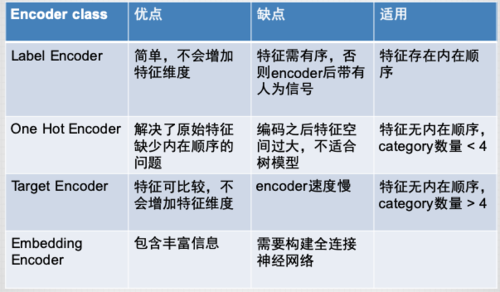在传统机器学习中,对于类别型特征有许多encode方法:
其中,Label Encoder是最简单的一种encode方法,并在sklearn.preprocessing中有实现方法,目的是将类别型特征统一转化成0-len(类别性特征)范围的数字。
既然只是对去重后的类别型特征进行某种方式的标序号,那么我们自己实现一个labelEncoder会不会比sklearn的要更快呢?
数据(test_data)
test_data.shape
(65022441, 1),总共65022441条数据
test_data.drop_duplicates(),去重后,test_data共有783行,即类别型特征有783个
我们分别使用三种方式来对test_data进行encode,分别是labelEncoder,通过reset_index进行编号,通过构建一个index 的dict进行编号,然后使用memory_profiler来分析三种方法对整个test_data进行encode的内存消耗和耗时情况。
labelEncoder
def encode_category_with_LabelEncoder(data, category_col): category_df = pd.DataFrame() category_df[category_col] = df[category_col].drop_duplicates() category_df[category_col+'_encode']=LabelEncoder().fit_transform(category_df[category_col].astype(str)) data = pd.merge(data, category_df, on=category_col, how="left")
reset_index
def encode_category_with_index(data):
category_df = df[[category_col]].drop_duplicates()
category_df.reset_index(inplace=True)
category_df[category_col+'_encode']=category_df.index
category_df = category_df.drop("index", axis=1)
data = pd.merge(data, category_df, on=category_col, how="left”)index dict
def encode_category_with_index_dict(data, category_col):
category_dict = df[category_col].value_counts()
category_dict = pd.Series(np.arange(0, len(category_dict)), index=category_dict.index).to_dict()
data[category_col+'_encode'] = data[category_col].map(category_dict).astype('int32')内存使用情况,以及耗时情况
import memory_profiler %load_ext memory_profiler %memit encode_category_with_LabelEncoder(test_data, ‘category') %timeit encode_category_with_LabelEncoder(test_data, ‘category')
peak memory: 24225.01 MiB, increment: 6077.23 MiB 22.3 s ± 1.15 s per loop (mean ± std. dev. of 7 runs, 1 loop each)
%memit encode_category_with_index(test_data, ‘category') %timeit encode_category_with_index(test_data, ‘category')
peak memory: 27573.56 MiB, increment: 9425.56 MiB 48 s ± 812 ms per loop (mean ± std. dev. of 7 runs, 1 loop each)
%memit encode_category_with_index_dict(test_data, ‘category') %timeit encode_category_with_index_dict(test_data, ‘category')
peak memory: 18892.13 MiB, increment: 0.00 MiB 13.4 s ± 74.4 ms per loop (mean ± std. dev. of 7 runs, 1 loop each)
其实后两种的编码方式思路是一样的,都是使用去重后的类别型特征的index为其编码,但第二种方式有reset_index和merge的开销,其性能不如labelEncoder,但使用字典存储index的思路来编码类别特征,效果几乎是labelEncoder的一倍。
点击查看更多内容
为 TA 点赞
评论
共同学习,写下你的评论
评论加载中...
作者其他优质文章
正在加载中
感谢您的支持,我会继续努力的~
扫码打赏,你说多少就多少
赞赏金额会直接到老师账户
支付方式
打开微信扫一扫,即可进行扫码打赏哦





